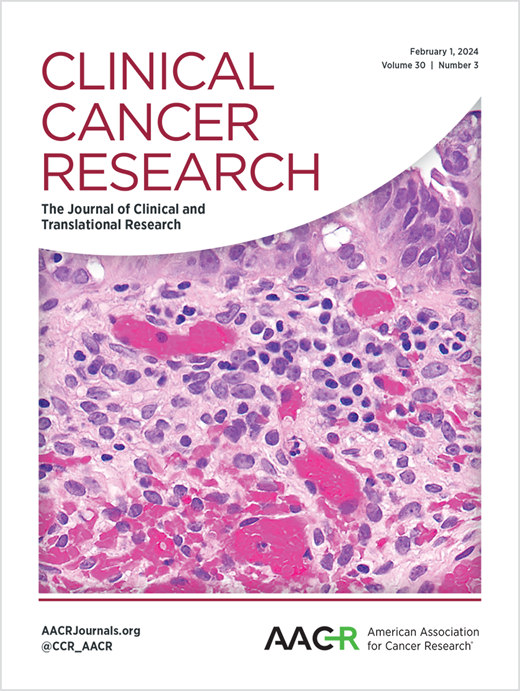Histology-specific clinical trial of lenvatinib and pembrolizumab in patients with sarcoma
IF 10.2
1区 医学
Q1 ONCOLOGY
引用次数: 0
Abstract
Purpose: Survival of patients with metastatic sarcoma remains poor, and there is pressing need for new therapies. Most sarcoma subtypes are not responsive to immune checkpoint inhibition alone. Lenvatinib, a multi-receptor tyrosine kinase inhibitor targeting tumor vasculature, has immunomodulatory activity that contributes to its antitumor effects. Therefore we hypothesized that combination of lenvatinib and pembrolizumab would lead to improved clinical outcomes in patients with sarcoma. Methods: This was an open-label, single-arm study of lenvatinib and pembrolizumab in the following cohorts A: leiomyosarcoma, B: undifferentiated pleomorphic sarcoma (UPS), C: vascular sarcomas (angiosarcoma and epithelioid hemangioendothelioma), D: synovial sarcoma or malignant peripheral nerve sheath tumor (MPNST), and E: bone sarcomas (osteosarcoma and chondrosarcoma). The primary endpoint was best overall response (BOR) rate documented by RECIST v1.1 by 27 weeks in each cohort, with a threshold of ≥2 responses among 10 patients. Secondary endpoints included progression-free survival, overall survival, duration of response and safety. Results: Forty-six patients were evaluable for the primary endpoint which was met in the UPS and MPNST/synovial cohorts (BOR rates by 27 weeks of 25% and 30%,respectively). There were 7 partial responses overall with additional responses noted in angiosarcoma and osteosarcoma. Treatment-related adverse events of any grade, and Grade 3 or higher, occurred in 50/51 (98%) and 29/51 (57%) of patients respectively. Conclusions: We observed durable responses in MPNST, synovial sarcoma and osteosarcoma. Patients with UPS and angiosarcoma also responded. Further exploration of this approach is warranted to confirm activity and determine optimal dosing schedules.来伐替尼和pembrolizumab治疗肉瘤患者的组织学特异性临床试验
目的:转移性肉瘤患者的生存率仍然很低,迫切需要新的疗法。大多数肉瘤亚型对单用免疫检查点抑制剂无效。伦伐替尼是一种靶向肿瘤血管的多受体酪氨酸激酶抑制剂,具有免疫调节活性,有助于发挥其抗肿瘤作用。因此,我们假设联合使用来伐替尼和pembrolizumab可改善肉瘤患者的临床疗效。研究方法这是一项开放标签、单臂研究,研究对象包括来伐替尼和pembrolizumab:A. Leiomyosarcoma;B. undifferentiated pleomorphic sarcoma (UPS);C. Vascular sarcomas(血管肉瘤):血管肉瘤(血管肉瘤和上皮样血管内皮瘤);D:滑膜肉瘤或恶性周围神经鞘瘤(MPNST);E:骨肉瘤(骨肉瘤和软骨肉瘤)。主要终点是每个队列在 27 周前根据 RECIST v1.1 记录的最佳总反应率 (BOR),阈值为 10 名患者中≥2 例反应。次要终点包括无进展生存期、总生存期、应答持续时间和安全性。结果46名患者接受了主要终点评估,UPS组和MPNST/同种异体组均达到了主要终点(27周前的BOR率分别为25%和30%)。总计有7例部分应答,血管肉瘤和骨肉瘤也有应答。50/51(98%)和29/51(57%)的患者分别出现了任何等级和3级或更高的治疗相关不良事件。结论:我们在 MPNST、滑膜肉瘤和骨肉瘤中观察到了持久的反应。UPS和血管肉瘤患者也有反应。有必要进一步探索这种方法,以确认其活性并确定最佳给药方案。
本文章由计算机程序翻译,如有差异,请以英文原文为准。
求助全文
约1分钟内获得全文
求助全文
来源期刊

Clinical Cancer Research
医学-肿瘤学
CiteScore
20.10
自引率
1.70%
发文量
1207
审稿时长
2.1 months
期刊介绍:
Clinical Cancer Research is a journal focusing on groundbreaking research in cancer, specifically in the areas where the laboratory and the clinic intersect. Our primary interest lies in clinical trials that investigate novel treatments, accompanied by research on pharmacology, molecular alterations, and biomarkers that can predict response or resistance to these treatments. Furthermore, we prioritize laboratory and animal studies that explore new drugs and targeted agents with the potential to advance to clinical trials. We also encourage research on targetable mechanisms of cancer development, progression, and metastasis.
 求助内容:
求助内容: 应助结果提醒方式:
应助结果提醒方式:


